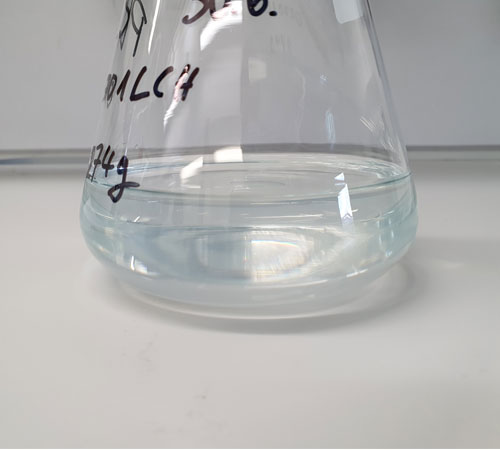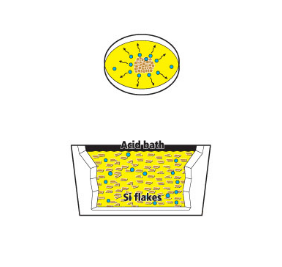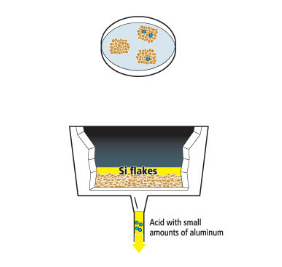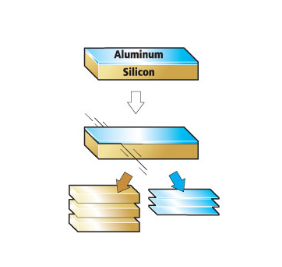Our Process
Here’s an in-depth look at our process, and how we’re different than the status quo.
At the heart of the Highland Materials proprietary refining technology is the aluminum-silicon (Al-Si) alloy system. Impure raw silicon (metallurgical grade) is smelted with pure aluminum allowing a low melting temperature saving significant energy.
When the aluminum-silicon melt is cooled again, pure silicon crystals which are purer than the raw input can grow from it. This first level of purification delivers two separate valuable products, a silicon containing aluminum master alloy (MA) and pure silicon flakes, a clean precursor of Highlands solar grade poly silicon.
In a second level of purification a wet-chemical process is used to remove the small amounts of residual aluminum sitting on the silicon flakes while producing Poly-Aluminum-Chloride (PAC) a byproduct used for wastewater treatment.
Finally, the processed flakes undergo a third level of purification when they are molten and cast into ingots in a controlled solidification process which drives out residual, dissolved impurities and can deliver highest purity silicon. The ingot is then chunked or shaped according to customer specifications.


This silicon product is essential in the photovoltaic industry to produce modern, highly efficient solar cells and modules. If you are interested in Highland’s silicon product, click here for more information!
Highland’s refining technology with its flexible by products allows development of other aluminum and silicon-based product lines, such as specialty aluminum alloys and silicon for anodes in Lithium-ion batteries. If you are interested in collaboration with Highland materials in such product development, click here to contact us!
Step 1
Metallurgical-grade silicon—with impurities such as boron and phosphorous—is dissolved in an aluminum smelt at a temperature of nearly 800⁰ C. This material has a purity of 97% or higher.


Step 2
As the liquid aluminum-silicon alloy crystallizes, the silicon hardens into flakes. The impurities remain in the aluminum, which represents the first stage in the purification process. Notice how the silicon has been “drawn” together and has an aluminum coating.
Step 3
The mixture cools, and the silicon solidifies. The liquid aluminum is then poured out. Because the aluminum now contains traces of silicon, it can be used as an aluminum-based master alloy.


Step 4
Acid is poured onto the silicon flakes to remove the remaining layer of aluminum.
Step 5
In the acid bath, the aluminum layer separates from the surface of the silicon flakes; this provides an additional layer of purification.


Step 6
The bath is drained. The liquid—polyaluminum chloride—is used commercially by wastewater treatment facilities.
Step 7
The remaining silicon flakes, which still contain traces of aluminum, are melted. The heat causes the remaining aluminum atoms to separate and migrate to the surface.


Step 8
The combination of aluminum and silicon cools. The remaining aluminum atoms form a thin layer on the surface. Removing this layer from the silicon is the final purification stage, and the resulting material is solar silicon.
Purity

